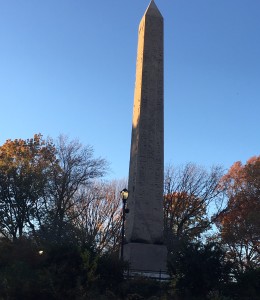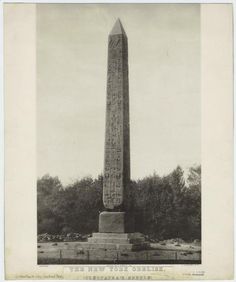
The obelisk rises above the trees like the uncurling index finger of something ancient reaching for the distant stars. The monument is inscribed in the faded hieroglyphs of a dead language, and at its base are four distinctly more modern black stone crabs that seem to be supporting the seventy-foot pillar between them. Beyond the Metropolitan Museum of Art, where thousands of artifacts lay in glass display cases under 24-hour security, the obelisk that has seen the rise and fall of over a hundred empires stands erected almost as an afterthought, accessible by a single path extending from the web of hidden wonders that is Central Park. Built around 1,450 BC, the 220-ton Egyptian obelisk is one of three stone obelisks gifted to Paris, London, and New York City in 1869. The gift marks one of the first times in history that New York City was given the same distinction as a major city, alongside its two older siblings. As a part of a deal to ensure better trade with Egypt, the obelisk was brought over to New York City as more than just another statue in Central Park to go with Alice in Wonderland and legions of dead authors, war heroes and politicians. It is the oldest artifact in the city. 1
The obelisks themselves have nothing to actually do with Cleopatra, as they existed for nearly a thousand years before she was born. Cleopatra’s Needle was erected in Heliopolis by Thutmose III aka the Napoleon of Egypt, in order to celebrate his 30 years of rule. Thutmose III, who engaged in more than 200 battles (without losing a single one, unlike Napoleon) is the first recorded general to launch a fleet across the sea and is statistically considered to be a greater Egyptian ruler and conqueror than the more famous Ramesses II. Twenty-four years after their inception, the statues were then toppled during the Persian invasion and remained in ruin for more than 500 years, before being picked up by the Romans in the name of Julius Caesar. 2
After the Romans brought the obelisks to Alexandria, they were kept in a Caesareum–a temple in honor of Julius Caesar. Cleopatra had dealings with the Caesareum at the time and so she was primarily associated with its contents (hence the name Cleopatra’s Needle). Long after the fall of Rome and the obelisks’ isolated abandonment, they were reclaimed by Egypt. 3

Moving the obelisk to New York City was a feat nearly as legendary as the exploits of Thutmose III, as it had to be transported on a US Navy ship, the storage capacity of which was only previously tested by a 100-ton cannon. Having spent a month-long journey at sea before reaching New York, the obelisk would have to wait another four months before it could be propped up in Central Park, only after being dragged by a rotating team of 32 horses from the Hudson River (keep in mind, much of Manhattan was still undeveloped countryside at this point). 4
In a letter to Mayor Bloomberg and the Central Park Conservancy, the Secretary General of Egypt’s Supreme Council of Antiquities Zahi Hawass said:
“I am glad that this monument has become such an integral part of New York City, but I am dismayed at the lack of care and attention that it has been given. Recent photographs that I have received show the severe damage that has been done to the obelisk, particularly to the hieroglyphic text, which in places has been completely worn away. I have a duty to protect all Egyptian monuments whether they are inside or outside of Egypt. If the Central Park Conservancy and the City of New York cannot properly care for this obelisk, I will take the necessary steps to bring this precious artifact home and save it from ruin.”
In response to Hawass’s concern, restoration began on the obelisk in late 2012. Over a century’s worth of dust and other contaminants had gathered on the obelisk, resulting in the use of lasers during the cleaning process. While it is still exposed to the elements, thanks to its restoration, the monument has only looked better in the rolling white sands of a society at the height of its power and glory. 5
Below the ancient obelisk lies a different sort of wonder in the form of a time capsule. Given how monumental the placement of the obelisk in Central Park was, a massive ceremony was held in its honor. Within the capsule are a copy of the Declaration of Independence, a book of Egyptian and freemason symbols, a Webster’s dictionary, and also various maps and other memorabilia of the time period. Of particular interest is a mysterious box containing undisclosed contents, which was provided by William Henry Hulbert, a US Consul in Cairo who had a hand in negotiating the arrival of the obelisk. In keeping with the many secrets and mysteries of the ancient Egyptians, Cleopatra’s Needle stands both as a monument to New York City and a salute to the past. 6
References
1. Kate Briquelet, “How Cleopatra’s Needle Got to Central Park,” New York Post, last modified June 15, 2014, http://nypost.com/2014/06/14/how-cleopatras-needle-a-3500-year-old-egyptian-obelisk-got-to-central-park/
2. Ibid.
3. Ibid.
4. “Obelisk.” The Official Website of Central Park NYC, accessed December 12, 2016, http://www.centralparknyc.org/things-to-see-and-do/attractions/obelisk.html
5. Lisa Foderaro “For ‘Cleopatra’s Needle’ A Cleaning To Last A Thousand Years,” The New York Times, last modified May 4, 2014, https://www.nytimes.com/2014/05/08/nyregion/for-cleopatras-needle-a-cleaning-to-last-500-years.html?_r=0
6. “Mystery of the Obelisks – Forgotten New York,” Forgotten New York, accessed December 1 2016, http://forgotten-ny.com/2007/09/mystery-of-the-obelisks-guest-page-by-martin-langfield-author-of-the-malice-box/
Nick Manzolillo
Contributor
